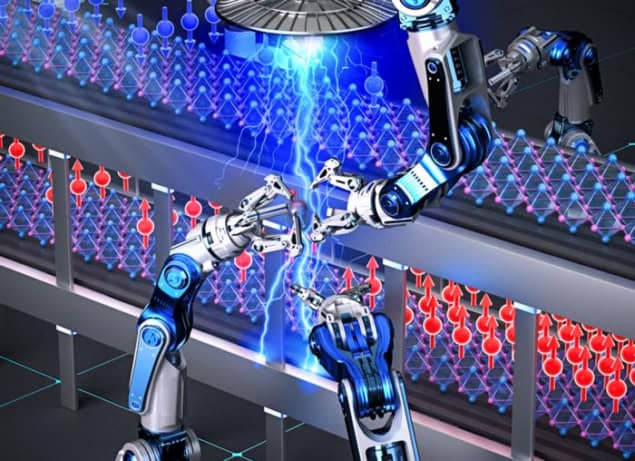Layer-spintronics makes its debut
 |
Researchers at the Singapore University of Technology and Design (SUTD) have developed a new all-electrical way of controlling spin-polarized currents. By using bilayers of recently discovered materials known as alter magnets, the researchers developed a tunable and magnetic-free alternative to current approaches—something they say could bring spintronics closer to real-world applications.
Spintronics stores and processes information by exploiting electrons' quantum spin (or intrinsic angular momentum) rather than their charge. The technology works by switching electronic spins, which can point either “up” or “down”, to perform binary logical operations in the same way electronic circuits use electric charge. One of the main advantages is that when an electron’s spin switches direction, its new state is stored permanently; it is said to be “non-volatile”. Spintronics circuits, therefore, do not require any additional input power to keep their states stable, which could make them more efficient and faster than the circuits in conventional electronic devices.
The problem is that the spin currents that carry information in spintronics circuits are usually generated using ferromagnetic materials, and the magnetization of these materials can only be switched using powerful magnetic fields. Doing this requires bulky apparatus, which hinders the creation of ultracompact devices – a prerequisite for real-world applications.
“Notoriously difficult to achieve”
Controlling the spins with electric fields instead would be ideal, but Ang Yee Sin, who led the new research, says it has proved notoriously difficult to achieve – until now. “We have now shown that we can generate and reverse the spin direction of the electron current in an alternagnet made of two fragile layers of chromium sulphide (CrS) at room temperature using only an electric field,” Ang says.
Altermagnets, discovered only in 2024, differ from conventional magnetically-ordered materials, ferromagnets, and antiferromagnets. In ferromagnets, atoms' magnetic moments (or spins) line up parallel to each other. In antiferromagnets, they line up antiparallel. The spins in alternators are also antiparallel, but the atoms that host these spins are rotated with respect to their neighbours. This combination gives alternomagnets some properties of both ferromagnets and antiferromagnets, plus new properties.
In bilayers of CrS, explains Ang, the electrons in each layer naturally prefer to spin in opposite directions, essentially cancelling each other. “When we apply an electric field across the layers, however, one layer becomes more ‘active’ than the other. The current flowing through the device, therefore, becomes spin-polarized.”
A new device concept
The researchers' main challenge in their work was identifying a suitable material and a stacking arrangement in which the spin and layers intertwined just right. This required detailed quantum-level simulations and theoretical modelling to prove that CrS bilayers could do the job, says Ang.Read more

The work opens up a new device concept that the team calls layer-spintronics, in which spin control is achieved via layer selection using an electric field. According to Ang, this concept has clear applications for next-generation, energy-efficient, compact, magnet-free memory and logic devices. And, since the technology works at room temperature and uses electric gating – a common approach in today’s electronics – it could make it possible to integrate spintronics devices with current semiconductor technology. He says this could lead to novel spin transistors, reconfigurable logic gates, or ultrafast memory cells based entirely on spin in the future.
The SUTD researchers, who report their work in Materials Horizons, now aim to identify other 2D alternagnets that can host similar or even more robust spin-electric effects. “We are also collaborating with experimentalists to synthesize and characterize CrS bilayers to validate our lab predictions and investigate how to achieve non-volatile spin control by integrating them with ferroelectric materials,” reveals Ang. “This could allow memory devices to retain information for longer.”
from physicsworld.com 2/5/2025
Δεν υπάρχουν σχόλια:
Δημοσίευση σχολίου